Creating a fursona is one of the most universal behaviours in the furry fandom.1 Defined as anthropomorphic animal representations of the self, furries interact with other members of the fandom through the use of these avatars, both in-person (e.g., badges at conventions) and online (e.g., profile pictures, forum handle). Fursonas can differ dramatically in the amount of detail they entail, and can include distinct personalities, histories, relationships, and attitudes. At very minimum, however, most fursonas include a name and a species.
Furries and non-furries alike frequently ask about fursona species, usually asking about the most unusual species or wondering what the most frequently chosen species are. In an online study, we collected information on more than 6,000 distinct fursonas, which were categorized into 852 unique species (which were subsequently organized for ease of presentation.)2
Many of the species listed were unique and, as such, cannot be presented in order to preserve the anonymity of our participants. In the figures that follow, such species are aggregated in the “other” categories for the most relevant group.
First, we present the data for all species. We then proceed with a group-by-group breakdown of popular categories. Within each category, “unspecified” means that the species was simply identified as the category (e.g., within the “wolf” category analysis, “unspecified” refers to people who just put “wolf” rather than any specific breed/type of wolf).
Please note that this category breakdown is not meant to reflect biological taxonomy or cladistics, but is instead meant to be a close approximation of how groups of similar species “clustered” together (e.g., the authors know that a wolverine and a badger are not “rodents,” but included them in with “small furry mammals” for ease of analysis).
* Note that the “other” category here represents 52.1% of all the listed hybrids (and represent unique or exceptionally rare identified hybrids).
In addition to assessing the most popular species furries choose for their fursonas, recent studies have also begun to look at other aspects of fursona choice. For example, one study recently looked at whether furries tend to choose fursonas that are more feral (look like an animal) or anthropomorphic (resemble a human).3 This question was asked as a 7-point scale ranging from 1 (Completely feral) to 7 (Completely Anthro). The results, posted below, reveal that the vast majority of furries create fursonas that are predominantly anthropomorphic.
In the same study, we also tested whether there were predictable differences in the type of furry who chooses a more anthropomorphic/feral fursona. Results revealed very few differences: therians were more likely to adopt feral fursonas (and, in fact, many would not even consider it to be a “fursona” so much as the animal aspect of themselves), as were women. Factors that were unrelated to fursona anthropomorphism included age, extent to which one identifies as a furry, sexual orientation, years as a furry, owning a fursuit, and mental health.
In an online survey4wolves are, internationally, still the most prevalent single fursona species. That said, this survey represented the first time that foxes have been outnumbered by a species other than wolf: namely, dragons, who took the second slot for more prevalent single fursona species. Also noteworthy in this survey, despite providing around 40 different categories to capture the most popular fursona species, nearly one-quarter of all furries indicated having an “other” fursona species.
Fursona Species Prevalance, 2020 International Online Survey
- Other: 23.9%
- Wolf: 20.7%
- Dragon: 16.0%
- Fox: 15.8%
- Hybrid: 14.0%
- Dog: 10.6%
- Housecat: 8.2%
- Other Big Cat: 6.9%
- Mythic/Mystic: 6.7%
- Tiger: 5%
- Lion: 3.4%
- Shapeshifter: 3.4%
- Deer: 3.2%
- Hyena: 2.8%
- Rabbit: 2.6%
- Raccoon: 2.2%
- Bear: 2.2%
- Otter: 2.2%
- Snow Leopard: 2.2%
- Reptile: 1.7%
- Pokemon: 1.5%
- Were-: 1.3%
- Skunk: 1.3%
- Bull: 1.1%
- Horse: 1.1%
- Phoenix: 0.9%
- Sergal: 0.9%
- Other Bird: 0.7%
- Goat: 0.7%
- Cow: 0.6%
- Mouse/Rat: 0.6%
- Unicorn: 0.6%
- Shark: 0.6%
- Crow: 0.6%
- Kangaroo: 0.6%
- Gryphon: 0.6%
- Snake: 0.6%
- Primate: 0.6%
- Raven: 0.4%
- Squirrel: 0.4%
- Dinosaur: 0.4%
References
- See 3.8 Number of Fursonas
- International Online Furry Survey: Winter 2011
- Anthrocon 2016 Study
- Summer 2020 Survey




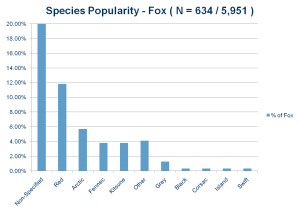
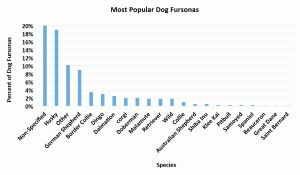
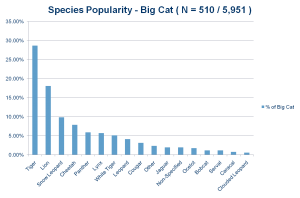

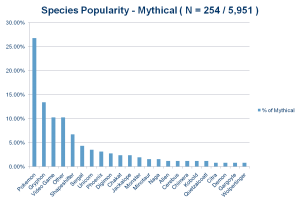

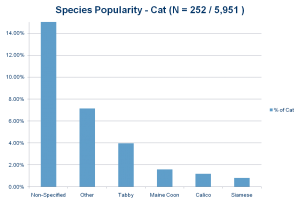
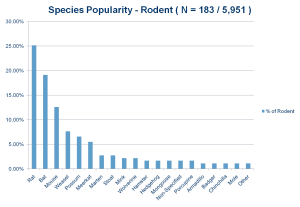
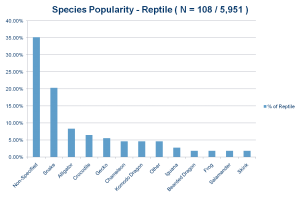
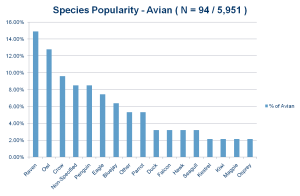
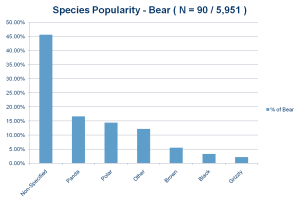
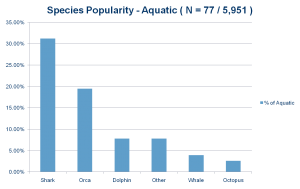
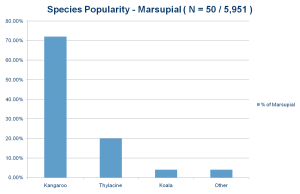
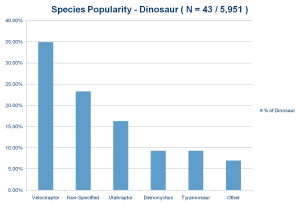
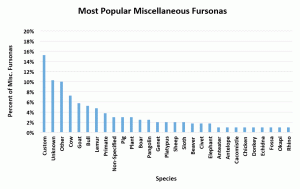
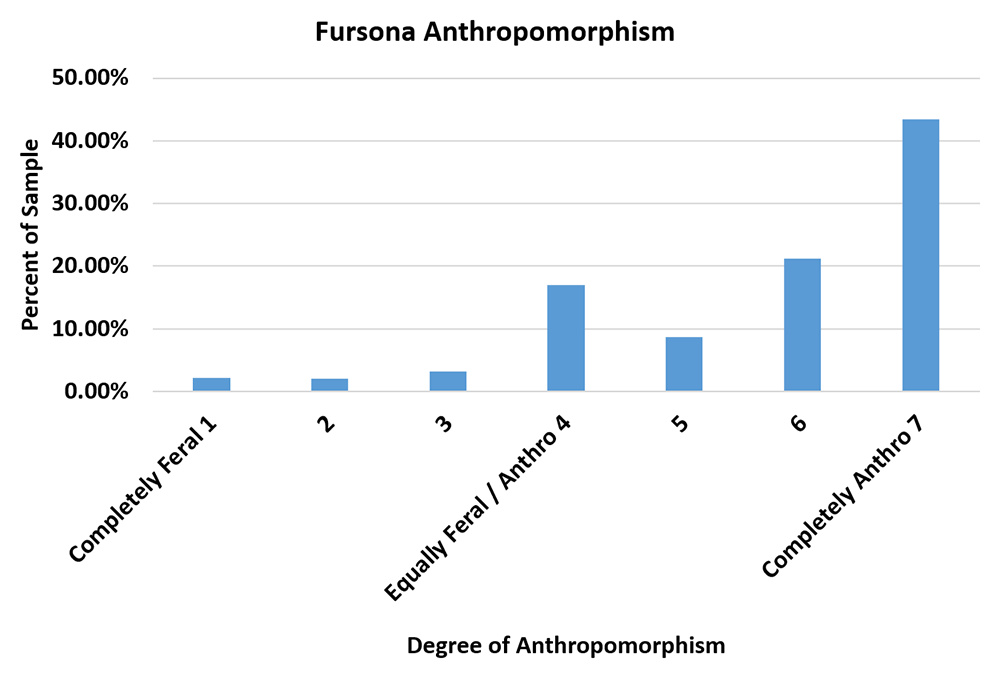
You have “bat” under rodents. Bats are actually more related to humans than to rodents! They should go in “misc”.
Can you add horse breeds please. I’m curious to see if more people like mytholical, draft, or standard horses
WHAT AB MANOKITS
Primates are monkeys, look on misc
I have a liger 😂
What are those foxes called that are sand coloured and have the really big ears, isn’t it called a fennec fox or something?
BAT IS BAT
r u sayin bats r monkys
That is not correct, bats are Chiropterans meanwhile both primates (including humans) and rodents are both Supraprimates due to their membership in the Clade Euarchontoglires. Rats and Humans are more closely related to one another than either one is to bats.
I’d like to point out that only 7 of the listed “rodents” are actually rodents. Someone calling a weasel or a stoat a rodent hits me on a different level;_;
We agree. In strict biological taxonomical terms, “rodent” does not apply to the non-rodent species you mentioned. Apologies, unreservedly 🙂
Here’s the good news/bad news: the inclusion of non-rodents under the rodent umbrella, which admittedly is not biologically correct, will be remedied in the future, but general taxonomy of furry species is harder than it seems, particularly because furry species don’t necessarily have biological analogues or adhere to strict cladistics.
We appreciate your patience, now and going forward 🙂 I believe the non-rodents will be happier in the next iteration.
Is there a hyena in here? Or did I just not see it…
Unfortunately not my friend. Mine falls under Canine or hybrid. African Wild Dog creature named Morbis
There is and I was thinking about making a hyena based fursona!
I am a rag dall cat! Add that into cats!!! >:(
This is true, they are related more to mammals than rodents, I think this was a observatory comment!
The rodents list is actually almost entirely non-rodents and even includes animals that are part of Carnivora just like cats and dogs ;_; the entire rodent part is a mess and would be better split up into actual rodents, non-canine Carnivorans, and misc mammals. Because the kind of person who has a rodent fursona is VERY different from the kind of person who has a meerkat fursona. (Meerkats are literally related to cats!!!)
Yes to the first part, not sure we have data to support the second–the “kind” of person is/ought to be different than…feels a bit anecdotal, but we can check the data and see if your hypothesis checks out. Best guess is that it’d be a perception question if the data exists, i.e., one’s lived experience informs that the kind of person whose fursona is X is measurably different than a different person whose fursona is Y, but that’s hard to say without seeing the data, and that’s also a very different pursuit than show there are actual measurable differences beyond perceived ones.
Can you add more about wolves plz?
I feel pretty left out…you don’t include squirrels or chipmunks. I’m a chipmunk myself and I’m bummed by this
There are squirrels.
Bats arent rodents 🙁
also squirrel power
Where proto
WHERE PROTOGEN
Data is submitted by participants who fill out surveys. We only include the species identified in any particular study or sample. This doesn’t mean the species you mentioned doesn’t exist, but that they weren’t captured (or didn’t meet an inclusion threshold) in this particular sample or study in which these data are presented. We’re currently reviewing all data for an up-and-coming book, and following that, we’ll update all data on this website which may include updated statistics on or inclusion of your aforementioned species.
“Custom” is listed in one of the charts, I think protogens fit into that category.
It feels like the only reason wolves are so popular is because you’re including coyotes as wolves, which doesn’t sound right, especially with them being the #1 species in there. Other than that, send like a pretty decent survey. Would love to see the percentages with “non-specified” removed from the statistics as they’re kinda useless as far as distribution in my opinion
Yes! Thank you for your comment. Please keep in mind that these statistics are older, but will be updated after the new book comes out later this year, 2023 🙂 We have loads more data, and that means more nuance, too!
yas agreed
yes! I am a wolf cat hybrid, and they said nothing about those.
A couple things…the species names are participant-generated from the surveys taken at the time, footnoted below. The word “popular” refers only to their frequency of occurrence in said surveys, and there are only so many categories on a chart, so each multiple mention of the same (ish) species needs to reach a certain threshold for inclusion–it’s not a judgement on the species type, just that more furries said X than Y, and only one furry said Z, so it wasn’t mentioned in this particular data set. It’s not practical to list every species ever mentioned in every survey.
What we can say about your wolf-cat hybrid is that your species type is probably contained within the category “other” in the “hybrid,” category along with all the other hybrids which were mentioned, but not frequently enough to have their own subcategory, if that makes sense 🙂
The hybrid graph cuts off at about 0.5%, so it’s safe to say if your species was mentioned, it was less than that. If you look at the subcategory of “other,” it’s about 10% of all hybrids, according to this data-set, so it’s a sizeable chunk of the hybrid community as a group. The better way to think of this is that Furries are wonderfully creative, and when you ask open-ended questions on a survey about species type, you get A LOT of wonderfully creative and often unique species, so deciphering, coding, and categorizing 1000s of answers is a long and difficult task…
Thank you for the comment: I hope you find more your species in the community, and you encourage all of your wolf-cat hybrids to participate in future surveys, and tell us all about your uniqueness 🙂
Heh, I think combinatorics is against us. Once you get past the most common (predator) theriotypes, things get wild. Consider that anything can be hybridized with anything else and it’s astronomical. Is there actually another wolf/gorilla in the universe. We should show up in Numberphile in the big number category.
I wish us chipmunks were more prevalent and represented
Yeah its actually sad that chipmunk are not that popular
I know, same…kinda sad that squirrels arent amongst like, foxes, we’re like super fluffy!
This helped a lot.
I’m guessing that Wallabies are a statistical anomaly then, huh?
Possums are marsupials..
i’m a wolf so can you add more about us
yeah
If you want more on wolves(like us) maybe find a different site. This is a lot of data. or run your own data, I’d like to see it X3
We have more data coming in 2023 🙂 Much of the species popularity data/comparisons are based on data that’s a bit dated, and we’ve since accumulated a lot more, which means we’ll be able to present a larger, more complete picture of species diversity and popularity across the fandom. Stay tuned!
When is this new data coming?
The plan is to overhaul this data section (here) with the all updated, recently collected and analyzed, data that supports all the findings in the new forthcoming book, tentatively scheduled for release late 2023/early 2024. That’s the plan anyway. Thanks for asking 🙂
Seriously? You put Weasels, Stoats, Mink, Meerkats, Wolverines, Martens, Badgers, Mongooses, Moles, Hedgehog, Armadillo, Bat, and Possum in Rodents? You really did like zero research, did you? Don’t claim to be doing science and then get this much wrong in a single graph.
Bats, Moles, Armadillos, Hedgehogs, Possums, and Mongooses & Meerkats are all in completely different Orders (Rodentia is an Order) from Chinchillas, Rats, Mice, Hamsters, and Porcupines… the same Order that contains Chipmunks, Squirrels, Gophers, Prairie Dogs, Capybaras, and Beavers. As for Weasels, Martens, Stoats, Minks, Ferrets, Badgers and Wolverines… they’re all Mustelids… which are Carnivores. This is akin to putting Bears in the same group with rats.
And you have no excuse for Possums… they’re Marsupials! You have that group. This is just sloppy.
In the general terms, our goal is to describe the fandom, as represented by Furries, not prescribe to the fandom. While we know those species aren’t rodents, biologically cladistically, they could be lumped charitably into the category small mammals, and rodent seemed small enough as a representative species for subcategory for grouping “like” fursonas of that type broadly, rather than strict biological taxonomy specifically. However, we appreciate some of the confusion, and perhaps rodent wasn’t the right term. The point of the chart was to illustrate and differentiate the popularity of the various fursonas within the fandom. The data is self-reported.
As an update, we’re currently working on recoding the classifications, and all of the feedback, including yours, will be considered.
So I’d like some more represent in the naked mole rat area
Hello hehehe nice to know there is a furry calculation here im a other hybrid species i call myself a guardian dragon type i mainly make peaple happy by protecting theem from the shadows that makes deepression i stay hidden that is why i dont post my drawing art of my self stay safe evryone love from the GUARDIAN SPECIES over and out.
As a Zoologist who also happens to be a furry, such a blatant scientific inaccuracy like this is really mind-boggling to me, especially if you are submitting any of this information for review by the greater academic community.
If you need a zoologist onboard your team, I would absolutely be happy to assist you at any time — even as a volunteer. One of my specializations is in taxonomy and cladistics, and it would only take me a matter of moments to devise an effective, concise, and scientifically accurate means of classifying the fursona species represented in our community!
I appreciate your comment, and I agree with you that it leaves a lot to be desired compared to a properly done taxonomy, but like I’ve said previously, it’s not meant to be that, and for this reason, I would ask for some patience and understanding.
These are just participant-generated lists of self-described species to demonstrate frequency of occurrence, categorized (and this is, again, where I agree with you) under some inclusive, meaningful (helpful?), general label, sufficient to lump them together as groups to get a snapshot of the data we’d compiled (at the time) into some kind of comparative list.
It’s not definitive, exhaustive, authoritative, nor prescriptive. The intent was to arrange the raw data and include as much as possible, so people, furries, non-furries, and the media, can see the diversity and creativity within the fandom’s fursona species. It’s also many years out of date, and so much more data has been compiled since.
As you know, biological taxonomy are describing phylogeny by common ancestry, but Fursona species are products of creativity, not evolution by natural selection. The may evolve, but their evolution is directed, unlike biological evolution.
I think for that reason, a biological analogous taxonomical standard might not be the most appropriate to account for the spontaneity and limitless creativity of fandom: e.g., we’ve had hybrid species listed as this or that animal plus muffin–yes, a muffin! What’s the monophyletic group for Muffin? Baked goods? What’s the Genus, species? Flour-based, sweetened with sugar Sub-family of edibles? It can get really interesting, and let’s be clear: no one will be 100% happy with everything anyway because fursona creation is very personal, and species creation, biologically speaking is, well, not: from Australopithecus to Ziziphus I’ve yet to receive a complaint, but leave Protogen off a list of fursona species (before they were an actual thing!), and I never hear the end of it–and yes, Proton is coming! We hear you, all of you 😉 🙂
I’ve given your comment a lot of consideration, I think the better analogous taxonomy would be something more akin to a genre-based taxonomy in much the way that musical genres are classed because the speciation events aren’t determined necessarily morphologically but how the creator (of each fursona) decides their fursona’s species, influenced by artistic styles, emulations from both natural and fictional analogues in their morphology. These are endlessly fascinating and wonderful, but they don’t always conform to any objective standard, I think you’ll agree.
Does that make sense?
How about this: if you, or anyone, have a correction, like “you classed bats as birds and s/b mammals,” note it, tag it, and pass it along to me (admin@furscience.com), and I’ll make sure the correction makes it to subsequent iterations, which hopefully, work better for all. This goes for species not mentioned, too, with the understanding that we’re not going around classifying species, but collecting data from Furries who classify themselves 😉
As for your offer to help, we have nothing formally to offer, and the issue isn’t a priority at this moment–we have A LOT going on, especially in the debunking dept. with all the haters–but it sounds like you have a lot of informed expertise and experience, and I’d be happy to hear some of your constructive suggestions on how you’d envisage a proper taxonomy while addressing some of the concerns I mentioned.
Send me, Malicious Beaver, an email at admin@furscience.com, and we’ll continue this conversation if you wish.
Thanks for your comment 🙂
Wow, Malicious Beaver, excellet comment. As a new memener of the genre I had no idea there was so much going on as far as species diversity.
So I’d like to say that I appreciate you comenting back to and for this web site as a whole.
I’d also like to add that i consider mydelf to be a hybrid of ghost/dalmation. So feel free to slassify me anywhere you’d like…except probably baked goods. lol
It was said in through beginning that it is not based of biology, but rather, what animals are similar, and rodents was defined as small furry mammal
Also frogs aren’t reptiles they’re amphibious lol
THANK YOU. I am genuinely distressed by the mis-classification of these animals. Along with these – jackals, coyotes, and maned wolves are not wolves! And frogs, skinks, and salamanders are amphibians. Chickens should be in the avian category.
include dutch angel dragons
yes I’m a dutch angel dragon myself and it isn’t there? Like what? I don’t see why they aren’t there because they are really popular so whoever made this must have known what they are. I’m also pretty sure telephone is a dutch angel dragon? Correct me if I’m wrong I’ve just got back into the fandom after about 2 years
The list is generated by answers to surveys. If enough participants check off “Dutch Angel Dragon” then the data will reflect that. The best way to ensure your species is represented is to participate in those surveys, so do it, and send it to all your Dutch Angel Dragon friends, and they, too, will be feel included.
and make protogens a own category
I’m personally a raccoon, and I would like to see it in the canine family
So im a deer cat hybrid any chance you g=could add it also my fursona name is deery
So… geese aren’t that popular? Perfect! PLAN G WILL BE PUT TO ACTION IMMEDIATELY!!!
I will join you, INITIATE PLAN G
Hey I just wanted to mention possums are marsupials not rodents! Love the article though!
Red pandas would be good to have in this.
My fursona is an eskimo dog + red panda! I know that hybrid is awkward, but hey, its cute-
This helped me to see that my fursona is unique
But I would like more alien dogs in the fandom though
Okay, there’s just one problem I have. I see that possum is in the rodent category. I don’t know if you mean the American opossum or the Australian possum, but either way, it would be in the marsupial category. Just had to say that, sorry. It just kinda triggers me. But other than that, it’s really great and interesting to me! ^^
where is protogen?
Protogen is a relatively new species, and though they’re popular enough to make it into a few surveys, more recently, they were just not frequent enough at the time the data was collected a few years ago. We’re looking to put together an updated list/graph sometime soon, so stay tuned!
now you’ll also have to ad primagen ;D
It would be nice to see possibly something about the original species of the fandom, such as Dutch angel Dragons, protogens, and other species that are created by the community.
I’m an hybrid fox/cat and it is aproximaly 2% :’0 it is interesting to be the 2% people. Incredyble document! ?
I am a wolf-cat hybrid and those weren’t mentioned at all, so I don’t know what % I am but hi all you Colfs!
hm i will try that and see
I relatively just looked for this so I could see the amount of otters.. How are then not more popular I mean just look at how they play in the water it’s adorable and awesome to have an otter fursona but people like what they like.
Are miscellaneous fursonas the and Other the same?
It’s been a few years since we compiled and graphed that data, but yes seems to be the answer to your question.
bat
opossums arent rodents at all actually! theyre marsupials, related to kangaroos and koalas. possums and opossums arent the same despite the name, im assuming you mean “opossums” like most people do
I am a duch angel dragon / goat and i looked it up and i didnt find any so i am in my own species cool
this is really helpful info!! do you think there will be updated info about original species such as dutch angel dragons, manokits, protogens, and skull dogs? It would be really interesting to see this side of the fandom!!
Wat bout protogen fursona?
Thanks! This is super super helpful for my adopt series (unusual anthros)
Please add Protogen to list
i was wondering if undead breed was a thing in the furry community
also is there any cyborg furrys by chance?
That is a protogen/primagen. Search it up!
Why the percentages add up to more than 100% for 2020 survey? Were participants able to select multiple options in that survey?
For some questions, we include a “check all that apply” option, which expands the range beyond 100%.
Opossums are actually marsupials and more related to kangaroos than they are rats and rodents
Roosters are even more rare theirs about 10 or so in the entire fandom and just 5 or so dedicated Roosters/Chickens.
Chickens rooster would be about .2 percent in there fandom lol
where is the kitsune (9 tail). I dont see it anywhere.
im going to do my own research but are there any shark/dragon hybrids or techincally sea dragons?
I am honestly appalled by this article. I personally have a house cat/velociraptor/blob fish fursona and I feel so underrepresented in the community. Please do more research next time and maybe try to ask people who actually are in the community instead of blatantly disrespecting us with the obvious outsider point of view.
Signed, an angry furry
If you fill out a survey and participate in any one of our studies, your data will become part of the overall analysis. We can’t count what we don’t know, but we know that there are things we don’t know, so we keep looking 🙂 We speak to thousands of furries across the globe throughout the year, live, in-person, at one of our many booths at some of the biggest cons in the world, and after our many research talks at cons, and online. If we’re not at a con near you, or one you’re able can attend, you can always participate through the website, or follow us on Twitter where we post links to surveys.
odds are 1 to 1000 OP is an actual furry lol
I added the percentage of the species prevalence and it gave me about 170% what’s up with that?
It’s being reviewed. Thanks for reporting 🙂
Ooof we lagomorphs a small bunch
Changed fursonas maybe
can someone list species of fursonas and such? i know theres things like, cats, dogs, bunnies, etc; but what about things like manokits, dutch angel dragons, skull dogs, protogens, nardo dragons, avalis, ect;
What about protogens???
Completely shocked that red pandas are not present. Maybe it’s a more recent thing, but I see them EVERYWHERE in the fandom nowadays.
Data is submitted by participants who fill out surveys. We only include the species identified in any particular study or sample. This doesn’t mean the species you mentioned doesn’t exist, but that they weren’t captured (or didn’t meet an inclusion threshold) in this particular sample or study in which these data are presented. We’re currently reviewing all data for an up-and-coming book, and following that, we’ll update all data on this website which may include updated statistics on or inclusion of your aforementioned species.
hey so i support everybody and there opinions matter to me but why don’t you all have penguins
—–
my fursona is a boar you know a wild hog his name is shaw and his wife is jade and she’s a monke and they have two half monke half boar children shadow and onyx
I don’t see a demon kaida (demon/wolf/dragon) anywhere
If enough participants describe a demon/wolf/dragon, and name the species “demon kaida,” it will appear.
Guess I’m basic but rare? I’m a Timberwolf, that’s kind of oxymoronic.
Contrary to popular belief, Hyenas are just as smart as primates according to Smithsonian
hey do you guys publish the underlying data here? i’m curious whether there’s a correlation between species and degree of anthropomorphism. my instinct says yes (feral dragons seem much more common than other ferals, at least), but it would be nice to quantify it. sorry if its somewhere obvious and i’m just blind
on a related note, do your surveys define the different levels of anthropomorphism in any visual way? i feel like if you just use words and a numerical scale you might get noise from people having different interpretations of the phrases “completely feral” and “completely anthro”. personally i would ask this question with reference to an example graphic along the lines of the “furry scale” meme. you might then run into some confusion if e.g. the character in question is a bird and the example graphic is a wolf, but i feel like overall it would be clearer. i hope it isn’t presumptuous to say this, i’m just interested in this particular survey item
Unfortunately, it’s harder to do correlation data with such diversity of species: a wonderful thing for furry creativity, not so easy for researchers trying to categorize and answer meaningfully scientifically interesting questions. However, as more data pours in, as more studies are done, larger pictures do emerge and loose concepts tend to get refined and have more nuance, so we’re optimistic that the results will only get better as we continue this research and continue to get amazing participation from the fandom!
I’ll pass your comment onto the Survey Methods Team to see if they can mine it for future research questions, too! Thanks for the feedback 🙂
I was really excited to read these charts, only to find that the data is ruined by inclusion of species in the completely wrong area. Bats and mongooses and minks and armadillos and stoats and wolverines and badgers and meerkats as rodents? Cows and bulls counted separately? Coyotes as wolves?
The rodent data is BEYOND messed up, over half of the included species aren’t rodents at all, and that throws off the numbers for the main comparison. This needs serious revision.
The short answer is yes. The slightly longer answer, I already gave, see Admin comment (above) on February 9, 2023 at 12:28 pm.
Suggestion – make the fursona’s specific species and fursona species’ family two different responses on the survey. This way you will have data on species as usual, as well as where fandom members FEEL their species fits (inspired by Rocko’s comment about raccoons belonging in canine family. Biologically, they do not. But perhaps some raccoon furries feel that they do, and that could be important to acknowledge.) This may be interesting to evaluate how furries’ feelings and perceptions about animals actually differ from their biology/cladistics, too. In my opinion – it seems these categories were determined by researcher’s perceptions about social groups within the fandom, which I feel is not best practice. If you want to create groups of species that don’t necessarily follow taxonomy, then you should be gathering data on how these groups should be put together instead of what seems like ‘going off vibes’.
I will pass on your suggestion and comments to the Survey Methods Team 🙂 Thanks! I will correct one assumption of yours:
There were not determined by perceptions or ‘feels’ as the kids say these days, but an attempt to create categories to include as much of the data collected (at the time), and represent it here, as was reasonable, helpful, and informative.
Also, for more on biological clades versus furries, see my comment here: https://furscience.com/research-findings/fursonas/3-1-species-popularity/#comment-421
Thanks, again for your feedback 🙂
Opossums and Possums are 2 very different animals. Broth are marsupials and not rodents. Opossums are the only North American marsupial and possums are an Australian marsupial.
Thank you for your feedback. Here’s the answer provided to similar types of criticism:
Really interesting stuff!
Since Pokemon are such a huge part of the “Mythical” graph, I would love to see a further breakdown of which ones are the most popular.
Opossums are marsupials. I realize from other comment replies you realize this, but I don’t understand your justifications. You’ve misrepresented the data such that a casual reading will leave people with misunderstandings. It’s furry bs, so it’s not like it matters much, but I don’t get purposely misrepresenting such a thing.
“purposely misrepresenting,’ indicates malicious intent, and you couldn’t be more wrong. In fact, if you read the previous replies, there is no way to infer that. As has been indicated several times, it was a taxonomical mistake for sure–you’re 100% correct–but with the intention at the time to include more data in broader categories and a genuine misplacement based on like kinds not necessarily actual cladistic categories with proper nomenclature. As has been stated several more times, when this page gets updated, this, too, will be corrected, just like “Protogen” as a category will be added–when the data was originally compiled “Protogen” as a species didn’t exist and/or wasn’t indicated on surveys sufficiently to justify a unique category. Our apologies to Opossums everywhere, whether anthropomorphic or members of the genus Didelphis (to be fair to the latter category, as of this writing, none have complained…yet) 😉
What do wickerbeasts classed as
They’re actually a species that was brought to our attention last year! Enough people wrote them in that we’ve started asking about them in our fursona species options this year 🙂
The cat section is weird. Tabbies, and calicos are pelt patterns, while Maine Coon and Siamese are cat breeds. It’s a bit odd. I feel like it would have been better if they are just coat patterns (tortoiseshell, colour point, tabby, ect).
Without doing a deep dive into some very old data collection, let me just give you a better idea of how the data is categorized. Furries who fill out the surveys decide the categories for the most part, so if participants list their fursonas by coat-pattern or a specific breed of cat (consistent or inconsistent with nomenclature for taxonomy purposes–I’ve covered that bit of misunderstanding, extensively, all over this comment thread!) or both, and/or just made up something unique to them, then that’s the data, and we’re left to arrange it in such a way that it makes sense to analyze it, and display it. Also, some of this data and analysis is from as far back as 2011, and we’ve collected over a decade’s worth of data including species and furona data from thousands of furries since then. For the latest data on species, check out our latest book here. With more participation comes more data points, and with more data points, categorization gets more nuanced. If you look at the 2020 link here, at the bottom you’ll see even if we suggest 40+ categories for species identification, nearly one-quarter of all furries indicated having an “other” fursona species, which don’t necessarily fit into a category, and sometimes, if they’re only a few, as compared to the smallest end of the presented data range, they just get lumped as other. If we a lot of cat species, and those species easily separated into big cat and house cats, and those subcategories themselves were populated with a great range of characteristics such that the distinct variable (every thing else being equal) among house cats, for example, was coat pattern, then we could have that category too, though it’s hard to say what value that would bring to the table at this point without seeing more data around it, and/or without a specific scientific question to answer…however, we’ve made improvements to how we categorize species, and we’ll continue to improve as we accumulate more data. We’re also always accepting feedback on survey questions, too, so if there’s a specific thing you’d like to know about, let us know, and we’ll see if we can add it to our next surveys. Thank you 🙂
I wish they added wolf cat hybrids in the hybrids section
If a certain threshold of participants fill out the surveys as wolf-cat hybrids, a section will come forth 🙂
Is the research for this still ongoing? If so, is it 2024 & more info and will it be updated soon? All the stuff I’m finding on here seems year-old, or is that just me, ahaha. Have a nice day, furs and fursplores! I’mma moggy if you wanna add that btws
Thank you for your comment and question 🙂 Yes, the research is on-going, but there is always a lag between the collecting the data, analyzing the data, publishing the data in peer-reviewed journals, and then making available here. The final two don’t necessarily have to be in that order, but we like to populate this site with data that’s been peer-reviewed in scholarly journals. In the meantime, the latest data collection of data and analysis can be found in our latest book, available to read/download (the digital version) for free here, or you can purchase your own hardcopy from Amazon 🙂
Oh, @F1r3st4r
I think moggies end up in the housecat/domesticated cat/domestic cat/pet cat categories 🙂
Admins is there a place like this for therians or do u not do dat 2? imma fox furry/therian fursona called Maxine and im called Foxine because its mix xd
“Yes,” and “almost” are the answers to your questions 😉 Yes, we do research on Therians, specifically, and will have a page on this site dedicated to it, but it’s not been populated with content yet, so almost 😉 In the meantime, if you want to read some of our data and analysis on Therianthropy, check out Chapter 20, Page 637 of our latest book, available for free (read or download) here with the title, “The Animal Within: Animal Attitudes and Therianthropy.”
What are the most common insect sonas? (Pls be ant pls be ant)
Thank you for your question 🙂 Presently, so far, too few data to be able to draw any conclusions–in any given sample of a thousand participants we might be lucky to get a single insect fursona–although, if we had to wager a guess, it might be moths. If you know many more insect ‘sonas, you can encourage them to participate in our surveys at any of the many cons we attend to collect data, and up those insect ‘sona sample sizes 😉
*scurries by*
Thnakeman approves!